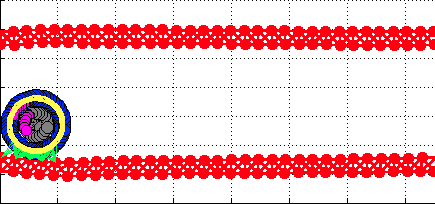Circulating tumor cell rolling along the blood vessel wall
 |
Goals:
Use the biomechanical model to investigate physical properties of the cytoskeleton of circulating tumor cells and cell-vessel adhesions that enable cell rolling on the vessel wall.
Mathematical Model: A classical fluid-structure interaction technique called the Immersed Boundary Method was used to model interactions between the cell and the blood flow inside the vessel during cell rolling on the vessel wall. Computational tools:i The model was coded using the Matlab system, and all images and movies are made also using the Matlab system. Author: Kasia Rejniak: labpages.moffitt.org/rejniakk |
| Simulation movie: this simulation presents a single tumor cell rolling on the vessel wall while pushed by the blood flow inside the vessel. circulating tumor cells are cells that detached from the primary tumor, entered into the blood system and are carried with teh blood flow until they extravasate and try to form secondary tumors (metastasis). In this model, the walls of the blood vessel are build from stiff Hookean springs [shown in red]. The cell cortex and nucleus are composed from linear Hookean springs and are shown in yellow and grey, respectivelly. Cell adhesions to the vessel walls are also modeled using linear springs [shown in green]. Note the dynamical rearrangement of adhesion springs--new adhesions are formed on the cell front, while adhesions on the cell back get removed. |